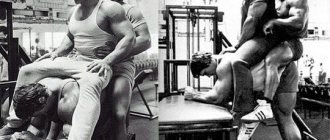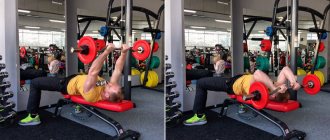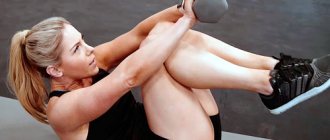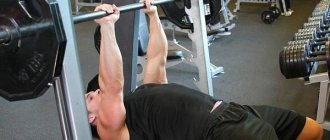Advantages and disadvantages
Lying hyperextension is an effective replacement for the machine exercise performed in the gym. The only difference is that when performing hyperextension while lying down, it is much more difficult to apply additional weights. That is, for experienced athletes with a high level of physical fitness, the “home” option is suitable only for strengthening and warming up. To develop the area, you will have to resort to a machine and work with additional weight.
Read more about hyperextension in the simulator →
Main advantages:
- Prevention of pain and prevention of problems in the lumbar spine (especially important with frequent sitting or prolonged walking).
- Strengthening the core muscles, the ability to keep your back straight longer in a standing position.
- Reducing the risk of injury (hernia, pinched nerves, etc.) when performing exercises or normal movements (bending, lifting any objects from the floor, etc.).
- Prevent muscle imbalances, pelvic tilt and other problems associated with weakened muscles.
The technique of performing hyperextension on the floor has only one drawback - a decrease in the amplitude of movement, in comparison with the version in the simulator.
However, if the technique is followed, this minus will have virtually no effect on the effectiveness of the exercise.
TYPES OF TWISTS
• The lower leg lies on a gymnastic bench forming an angle of 90 degrees (foot-knee-thigh);
• The legs are suspended, the shin is parallel to the floor;
• Incline bench crunches;
• Simultaneous twisting of the body and pulling up the legs , hands stretching to the toes (when the body and legs are pulled inward, exhale as much as you can, while simultaneously straining the abdominal muscles, inhale while extending);
• Reverse crunches - the essence of the exercise, the upper body lies motionless on the floor, legs bent at the knees while suspended, begin to pull up to the chest in a semicircular movement, lifting the pelvis and lower back. In the final position, the knees should be in the chest-head area.
https://youtu.be/F86KLvmRCp4
What muscles work
The main burden falls on:
- Back extensor muscles (iliocostalis, spinalis, longissimus).
- Gluteal.
- Biceps femoris.
When working on the floor, the hamstrings are used to a lesser extent than in the machine. This allows you to better load the erector spinae muscles and potentially increase the effectiveness of the exercise.
About the benefits of this exercise
When you perform crunches on the floor, the rectus abdominis muscle is engaged, and in addition the external obliques are also worked.
Since this exercise does not require any special equipment, it can easily be done at home for those who want to work out their abdominal muscles well.
Note: For well-trained athletes, crunches can be performed while lifting additional weight.
Technique for performing hyperextension at home on the floor
Despite some similarities, the floor hyperextension technique differs from the superman exercise. These are two different types of movement, although both are aimed at strengthening the lower back. If you have pain or problems with the spine, it is recommended to perform hyperextension as a safer option (with a lesser degree of hyperextension in the lumbar region).
Technique:
- Lie face down on the floor. Secure your legs with the help of any support (for example, the bottom of a sofa) or a partner. Hands behind the head, legs brought together, the body forms a single line.
- Begin to slowly lift your chest off the floor, rising as high as possible.
- Take a short pause (0.5 seconds), then lower yourself to the starting position, maintaining tension in the muscles.
There is also an option to perform the movement without fixing the legs , but it promotes swaying and excessive tension in the lower back, which negatively affects the benefits of the exercise.
To increase efficiency and difficulty, it is recommended to extend pauses at the top point (up to 3-4 seconds). Such a prolonged concentration of tension will significantly enhance the effect of the exercise even without the use of additional weight.
Benefits and harms
Let's start with the positive side of the coin. The main advantage of pole dancing as a hobby is the acquisition of holistic and harmonious physical development. If you do it correctly and pay enough attention to your training, the results will not take long to arrive -
On the other hand, this sport cannot be done without certain problems. One of them, common especially among beginners, is bruises, contusions and sprains. At first they will definitely appear and you will have to put up with them for some time. Special ointments such as bruiseOFF, Rescuer 911 and Troxevasin are suitable for healing.
Frequent pain is another characteristic side feature. In this case, it is not an indicator of muscle growth, but rather an indicator of the adaptation process. Injuries to ligaments and joints are not uncommon here, and therefore it is important to learn to distinguish the sensation of soreness from sprains.
Recommendations
The execution of the exercise depends entirely on the purpose of the training. If the main goal is gradual strengthening of the area or prevention , then hyperextension is performed in 3-4 sets of 10 repetitions. This is enough to provide the necessary load. To avoid problems with recovery, it is recommended to do no more than two workouts per week.
If the goal is pumping or developing the lower back , then it is optimal to increase the number of sets to 4-5. 12 to 15 repetitions each. Athletes with a high level of training can perform the last 2 approaches until complete muscle failure occurs. In this case, the rest between such sets should be at least 3-4 minutes.
When considering hyperextension in a general training program, the exercise should be used in the following cases:
- On back day, towards the end of the workout.
- As a warm-up before deadlifts or bent-over barbell rows (1-2 sets without weight, 10-12 reps).
- Before bench presses and in a standing position (relevant only if the athlete does not use a weightlifting belt).
In full body programs or alternating top/bottom exercises, hyperextension is best performed in conjunction with abdominal exercises. Training antagonist muscles will not only increase the effectiveness of exercises, but will also help avoid imbalances in muscle development.
Push-up program for a month
Once you learn proper push-up technique, the beginner program will help you progress further. It is clear that not a single person can do a hundred push-ups from scratch; the number of repetitions increases gradually over the course of a month. Training should be done every other day, and for your own convenience and so as not to forget anything, make yourself a table of push-ups with an exercise diagram. A weekly push-up program is developed according to the same principle. You can ask a trainer to help you find a suitable training plan. The best results will come from those who, in addition to training, control their nutrition. The programs are different for women and men.
A program to increase your push-up count in 15 weeks for beginners.
How many times should you do push-ups?
Don't expect push-ups to produce the rapid muscle growth or other results you expect in the first week. It will take at least a month of hard work to achieve results. So, how to increase the number of push-ups:
- for women to reach 40 in a month;
- men reach 100 in the same time.
According to a simplified scheme, girls need to learn to do 30 push-ups at the end of the training cycle, men 50. If desired, increase the number of repetitions as much as the body’s endurance allows.
It is enough to spend 15 minutes a day training. Decide in advance whether you are training endurance, want to burn excess fat, or need to bulk up. The most effective results will be if you perform a set of exercises, and not just push-ups.
How long to rest between sets?
Rest is necessary. After doing push-ups, rest for 1 minute before the next approach, but if you are still very tired, you can rest longer. But try to ensure that this time does not exceed 4 minutes each time, otherwise the muscles will “cool down”.
How many times a week do you train?
You shouldn't do push-ups every day. Contrary to popular belief, this is ineffective. To develop harmoniously, it is better to train 3-4 times a week, so the muscles will not be overly stressed and will have time to recover. For convenience, make yourself a schedule.
Who should not practice on the pole?
I would like to note that if you do not have adequate physical fitness, it is better to sign up for classes only after doing aerobics or in the gym for some time. Otherwise, you will not be able to avoid injuries during lessons.
You should also exclude such activities if you have high blood pressure and severe problems with the vestibular system.
Other medical contraindications
- Aggravated inflammatory processes and infectious diseases.
- Chronic diseases.
- Psychological and mental disorders.
- Physiological disorders of the central nervous system.
- Diseases of the musculoskeletal system, spinal pain and joint problems.
- Heart diseases.
- Previous strokes and heart attacks.
- Pregnancy.
- Postoperative period.
- Epilepsy.
- Bronchial asthma.











